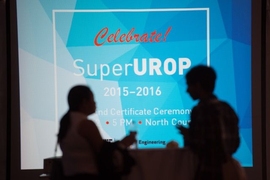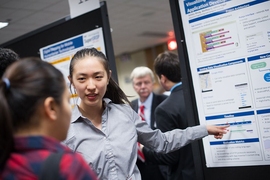Ignacio Estay Forno handled his research project with care. “It was like my baby,” says the junior, who is majoring in electrical engineering and computer science (EECS).
His project, conducted in collaboration with graduate student Di Zhu in EECS professor Karl Berggren’s lab, focused on developing an array of detectors that could spot single photons, furthering a technology that is used in fast-paced communications and can reach near-gigabit speeds between the Earth and the moon. “I was involved heavily in every single step,” Estay Forno says.
First, though, he had to learn about the lab’s work and understand the underlying theory. Only after months of running simulations could he go on to the building stage, he says.
Handling his device — a centimeter-square chip packed with nanomaterials — was stressful: A speck of dust could break it. But he also found the work exhilarating. Part of the fabrication process, which involves temperatures just a few degrees above 0 Kelvin, required Estay Forno to swaddle his chip in aluminum foil and dunk it in liquid helium. “I thought that was really cool,” he says.
Estay Forno is one of more than 140 undergraduate students from across the School of Engineering who took part in the Advanced Undergraduate Research Opportunities Program (SuperUROP) this year. SuperUROP, launched by EECS in 2012, offers a turbocharged version of the semester-long UROP program. SuperUROP students spend 10 hours each week in the lab. At the same time, they take the 12-credit Seminar in Undergraduate Advanced Research (6.UAR), in which they hear about current research and learn to communicate their results. Most present the results of their research at live events, such as the late-fall SuperUROP poster session and the spring EECScon event; many contribute to professional papers or publications.
This year’s SuperUROP program included students from the departments of Aeronautics and Astronautics, Biological Engineering, Chemical Engineering, and Civil and Environmental Engineering as well as from EECS.
Inquiring minds
"What's powerful about UROP is it takes our undergraduates and puts them shoulder to shoulder with grad students, and, with faculty, has them solve problems that haven't been solved before,” says School of Engineering Dean Ian A. Waitz, the Jerome C. Hunsaker Professor of Aeronautics and Astronautics (who will become MIT’s vice chancellor on July 1, overseeing the offices for graduate and undergraduate education). “What’s neat about SuperUROP is that it just takes that [experience] and amplifies it.”
A longer research experience lets students invest more energy in their projects and reap greater rewards. “You get to build something that actually matters,” says Alex LaGrassa, a junior in EECS who worked on teaching robots to understand natural language commands.
“We're trying to work on a paper now; that's not something you can do during an IAP [Independent Activities Period] project,” because research inevitably requires time, LaGrassa says. “You'll try a bunch of ideas and only one of them will work.”
By offering an authentic slice of the research life, SuperUROP can help students decide their future careers.
“I was really unsure whether or not I wanted to [eventually pursue a PhD] at the beginning of the year,” says Sarah Hensley, who worked on fine-tuning control of MIT’s humanoid robot, Valkyrie. Now the senior in EECS is planning her classes and master's of engineering research with a future doctorate in mind.
For Maya Nasr, a junior in Aeronautics and Astronautics, SuperUROP “was an awesome experience,” she says, and one that she’ll be able to vividly describe when she applies to graduate school in the fall. “I really loved the program,” she says. “I wish I could do it twice."
Science stories
The course component of SuperUROP also bolsters student success. The 6.UAR course has several deliverables that let students practice communicating their work to wider audiences, including their peers.
“Learning how to communicate to each other was one of the biggest things I learned,” says William Moses, a senior double-majoring in EECS and physics. He especially enjoyed participating in small groups with other students, where they could see each other’s presentations and offer feedback.
In the fall, SuperUROP students all prepare a proposal, poster, and one-minute elevator pitch for their work. In the spring, they detail what they’ve done, in an eight-page paper. Moses recounts that the course professors — Anantha Chandrasakan, the Vannevar Bush Professor of Electrical Engineering and EECS department head; Dennis (Denny) Freeman, the dean for undergraduate education; and Dina Katabi, the Andrew and Erna Viterbi Professor of Electrical Engineering and Computer Science — wanted students to gain these skills because they would “be important wherever we go,” Moses says.
Moses has already put those skills to use. He co-authored a paper on a method that allows programs to more efficiently run on multiple processors, and shared the award for best paper at the annual ACM SIGPLAN Symposium on Principles and Practice of Parallel Programming (PPoPP) in February.
Suma Anand, who worked on a device shaped like a bat ear that is designed to assist blind people, says she especially enjoyed writing her paper for the course. “It was a chance to really take a step back and see everything that I’d accomplished,” says Anand, who collaborated with Aude Oliva, a principal research scientist in the Computer Science and Artificial Intelligence Laboratory (CSAIL).
The work of the SuperUROPs hasn’t gone unnoticed; at a reception honoring the students in May, Chandrakasan beamed. “It's really amazing to see the transformation from the very beginning — the proposals last September and October — through the conclusion of your projects,” he said. “Congratulations to all of you.”
Researcher’s apprentice
The students have forged new paths at the research frontier. But they’re quick to point out that they didn’t do it alone. Anand’s mentor, postdoc Santani Teng, was “amazing,” Anand says. “He was always willing to make time to meet with me, help me seek out resources, and offer advice.”
Teng, for his part, says Anand was a full partner in their work. While he brought a neuroscience perspective, Anand brought software-engineering experience. “There was no way I could’ve done this on my own in a practical amount of time,” Teng says.
Another mentor, postdoc Rabia Tugce Yazicigil, helped EECS senior Daniel Richman understand how to approach research, a process that can be as disorienting as wandering in a forest. “There're lots of directions you could go in,” Richman says. Yazicigil helped point him in the right one. For example, she would have them first think of the figures they wanted for their future manuscript, and let those inform their research design.
That approach is a far cry from tackling a homework assignment. “When you do a problem set, you're thinking forward,” Richman says. In other words: you have the problem and you work relentlessly toward the solution.
But research? That’s a different beast. “You go back and forth,” Richman says. “You're thinking of the problem, but you're also trying to envision its solution … and filling in the space between.”
In addition to sharing her approach, Yazicigil, who’s still working with Richman, says she uses the Socratic method to guide him. “I try to ask him the right questions,” she says. “If he tries to figure out the answers, it’ll help him to go to the next step as well.”
On a recent spring morning, Estay Forno gleefully posted on Zephyr, an MIT chat system, that his research baby had just grown to a two-by-two array: a milestone his system had never reached before. Smiling, he says, “I’m really glad I did SuperUROP."











